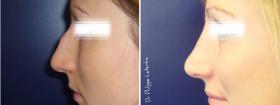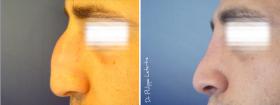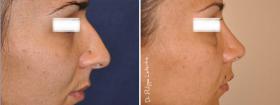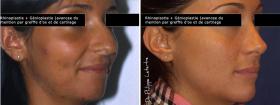Nose cosmetic surgery Nose reshaping with Rhinoplasty
What are the motivations for a Rhinoplasty ?
The nose surgery may be motivated by :
- Functional concerns : such as problems with nasal breathing.
- Aesthetic concerns : a bump, a nose too large, too long, crooked...
- Consequences of traumasuch as an aesthetic or respiratory discomfort...
- Small dysharmonies corrections such as a small bump.
In medical cases, an assumption by social security is possible, but after consulting the Medical Officer of your CPAM.
What are the objectives of cosmetic surgery ?
The purpose of a rhinoplasty is to make your nose match with the other facial features, in order to suit the request and the patient's personality.
The ultimate purpose is a natural, harmonious result and a satisfactory respiratory function.
Importance of 1st consultation
As with any cosmetic surgery, a Rinoplasty involves risks to know, pre-operative examinations to practice and protocols to follow. During your first consultation, you get a professional answer to all your questions and concerns.
A careful study of the nasal pyramid compared with the rest of the face is made, as well as an endonasal examination. A simulation using photographs or photo morphing software gives you an idea of the result.
Changing one’s nose always leads to a transformation in your face and communication with your surgeon is important for him to guide you in this intervention.
In case of small corrections
Some disharmonies can be corrected by an injection of hyaluronic acid ( Juvederm, Restylane, Perlane, Téosyal) or Radiesse.
This correction is performed by nose reshaping without surgery in the doctor’s office.
What happens during the surgery ?
The surgeon makes an incision that differs depending on the area to correct.
Then he is going to reshape the osteocartilaginous framework of the nose following what you have agreed on together.
The skin is finally redraped and the incisions sutured with absorbable thread.
+ What is the type of anesthesia ?
According to the case, anesthesia may be local, deep if administered intravenously by tranquilizers or general. This will be the subject of a discussion between you and your surgeon during a consultation.
+ Where is located the incision ?
The incisions are usually hidden inside the nostrils but can be outside, especially when it comes to reducing their size, to correct the nasal tip or when the deformations are too large. In these cases, the incisions are hidden in the fold of the nose wings or across the columella (base of the nose).
+ And the scar ?
Resulting from the incision, the scar is invisible in most cases and hidden up in the fold of the nose wings or across the columella in the most usual cases.
+ How long is the surgery ?
The length of the procedure varies between 1 and 2 hours.
What are the postoperative courses ?
Hospitalization usually lasts a day or takes place on an out-patient basis.
The postoperative course is almost painless, but some discomfort to breathe through the nose is felt. Bruising (bruises), an edema (swelling) and watery eyes appear on the treated area, but gradually disappear.
The first days, you have to rest up as much as possible and avoid any violent effort. Wicks or drains are removed between the 2nd and 5th day.
The splint is withdrawn between the 5th and 8th day, it will sometimes be replaced by a new and smaller splint for a few days.
The return to a normal socio-professional life ranges from 10 to 20 days depending on the extent of the postoperative course.
Sport and great efforts are not recommended during the first 3 months.
What is the expected result ?
You must wait 2 to 3 months to get a good overview of the result, but be aware that the final result will be obtained after six months to one year.
It usually responds to the expectations and the established project.
The benefit is significant on three points: Aesthetic, functional and psychological.
The result is permanent and aging retakes a normal course.
What are the possible complications ?
Following any operation whatsoever , certain complications can occur, the first ones related to the medical activity and the others to anesthesia.
Although possible complications only represent a small percentage, it is necessary to know them.
+ What are the specific risks of the surgery ?
During the consultations with your surgeon all the possible complications will be detailed to you . Fortunately the real complications are quite unusual.
- To inform you in advance, here are the possible risks :
- An hematoma : requiring evacuation.
- An infection : which may require antibiotic treatment.
- Temporary modification of sensitivity of nose and sense of smell.
These informations given by Dr. Philippe Letertre should only be a help or a supplement to your surgeon’s consultations
Our space "Questions / Answers" is also available for you.
Feel free to contact Dr. Letertre
so that he could meet your expectations.





